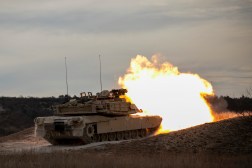Army poised to launch revamped cArmy cloud services environment

The Army plans to introduce an improved cloud infrastructure in the coming weeks that will streamline how users are able to access secure cloud capabilities, according to the service’s chief information officer.
The new version of the Army’s cloud services infrastructure — dubbed cArmy 2.0 — aims to build upon the foundations of recent cloud modernization efforts and make key improvements to them, Army CIO Leonel Garciga said Tuesday during a webinar broadcasted by Federal News Network.
A new landing zone for cArmy 2.0 will be available in April, he said.
The move to the revamped environment comes after the Army took a “tactical pause” over the last couple of months to reevaluate its cloud delivery model, he noted.
“Like most traditional folks in enterprise’s big move to the cloud, we raced in some areas, we made some mistakes, we did some things that made sense at the time that don’t make as much sense now,” Garciga said. “And as new cloud services have become available in the regions across all of our [cybersecurity service providers], it’s really caused us to rethink some of the technical work that’s been done.”
As part of a larger push across the Defense Department to embrace the cloud, the Army stood up its Enterprise Cloud Management Office (ECMO) in 2019 and introduced cArmy the following year. According to the service, cArmy is a multi- and hybrid-cloud ecosystem that provides tenants with common cloud shared services in a secure ecosystem. Amazon Web Services and Microsoft Azure currently serve as services providers for the cloud environment.
After evaluating how cArmy has performed over the last three years, the Army wants the follow-on version to offer more agility for users — especially as the department continues to experience more demand for cloud services.
Garciga said a key goal for cArmy 2.0 is to introduce automation and simplicity into the cloud architecture to improve overall delivery.
“Those core services that tenants are receiving are going to be way easier to execute moving forward, as opposed to right now where it’s a little clunky,” he said.
The Army also wants to use automation to streamline onboarding services for new customers, as well as making sure to provide as much critical information to users as soon as possible, Garciga noted.
“What does the environment look like? What do our images look like? What baseline managed services are we delivering as an Army to you, the tenant? Getting that out is hugely important,” Garciga said. “Our focus is going to be making sure that we make that available to all the folks that are coming into the environment.”
In addition, cArmy 2.0 will focus on platform-as-a-service (PaaS) and software-as-a-service (SaaS) cloud deployments — rather than infrastructure-as-a-service (IaaS). Doing so reduces the overall delivery timeframe, he said.
Along with the new version of cArmy, Garciga also emphasized that his department is still embracing the Pentagon’s Joint Warfighting Cloud Capability (JWCC) as it pivots away from using the Army’s own cloud service provider reseller, known as Cloud Account Management Optimization (CAMO). At the moment, the Army has two contracts moving through the JWCC pipeline, he said.
“We continue to use this mix of [Commercial Cloud Enterprise] on the intel side and for some workloads, and definitely CAMO for unclassified workloads and our existing workloads as we really get that footprint set up in JWCC,” Garciga said.






